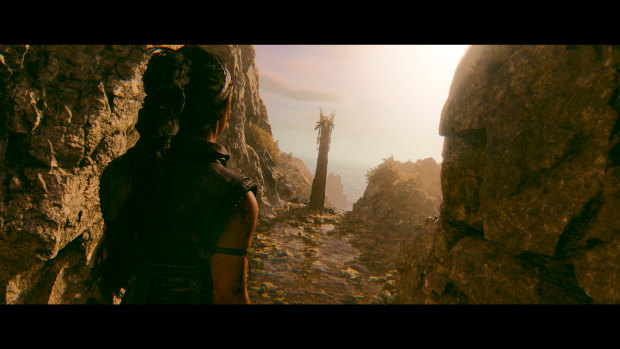
Often poetic, but also conversational or outright rambling, they’re a near-constant presence that is sometimes comforting, sometimes overwhelming, and occasionally informative, counter-balancing the fact that there are no visual interface elements (such as health bars, maps, compass pointers or combat indicators) to speak of at all.
In the first game it could feel ambiguous whether the things Senua saw and the challenges she faced were part of objective reality or were only seen by her. However, things are more complicated this time around as, rather than a personal journey, she voluntarily takes on a burden to stop slavery and sacrifice by slaying a number of gruesome giants that have been pillaging the Vikings’ land.
Senua’s companions, her discoveries and the wider world around her seem to confirm and even explain her beliefs, and it’s clear she has more agency and control than she did before.
Yet, by the game’s end, the twisted narrative has arrived once again at a place of unsure meaning and allegory. Between the apparent reality, and the seeming commentary and reframing of that reality, it’s a level of abstract storytelling very few games attempt, let alone pull off this effectively.
The story provides plenty to chew on, with its moral relativism and arguments about where evil comes from, though it does suffer slightly from that familiar video game problem of forcing your character to perpetrate unavoidable violence in order to progress.
Loading
However, compared to something like The Last of Us Part II (where I ended up practically screaming at the characters to consider each other’s perspective for two seconds), the player can generally feel that they’re a force for moral good, as Senua strives for compassion in a violent world, while contending with what it means to have power over people, and what happens when you fail them.
Visually, it’s a stunning game, with Icelandic and other-worldly environments that do at times appear real. Outfits and armour in the game were also built as authentically as possible before being scanned in, and all the character movements were performed by human actors using complex capture and digitisation techniques. However, games aiming for veracity like this have always had to make compromises – for example, you gain fidelity but lose fine control, or end up with obvious breaks in the experience where preset animations become controllable action – and Senua’s Saga is no different.
In fact, the weakest parts of the experience are also the “gamiest”; repetitive combat scenes where you need to time your strikes and counters, and roadblocks that require you to walk around an area spotting symbols, don’t compare well to the most dynamic video games.
On the other hand, some of the more abstract sequences, regarding the giants, or tip-toeing around abominations in a pitch-black underworld, or a disconcerting detour through a malevolent foggy wood, simply wouldn’t work as well if this were a film, rather than a game.

The world is built with photogrammetry collected from Iceland, but houses many surprises.
Ultimately, you could view this as a very linear game, with essentially no story choices to be made, and no optional paths to explore, beyond some hidden audio lore dumps and an interesting post-game unlockable that encourages a second play. Or you could view it as a glorified CGI film. However, it’s more than both of those things combined.
The honest attempt at the representation of a very specific mental affliction in this game, albeit in a fantastical setting, is worthy of recognition in itself. Add the frequently awe-inspiring visual presentation, the extraordinary audio experience, light horror scenarios and a cerebrally intriguing narrative, and it all adds up to something unique and very much worthwhile.
Get news and reviews on technology, gadgets and gaming in our Technology newsletter every Friday. Sign up here.









 Add Category
Add Category